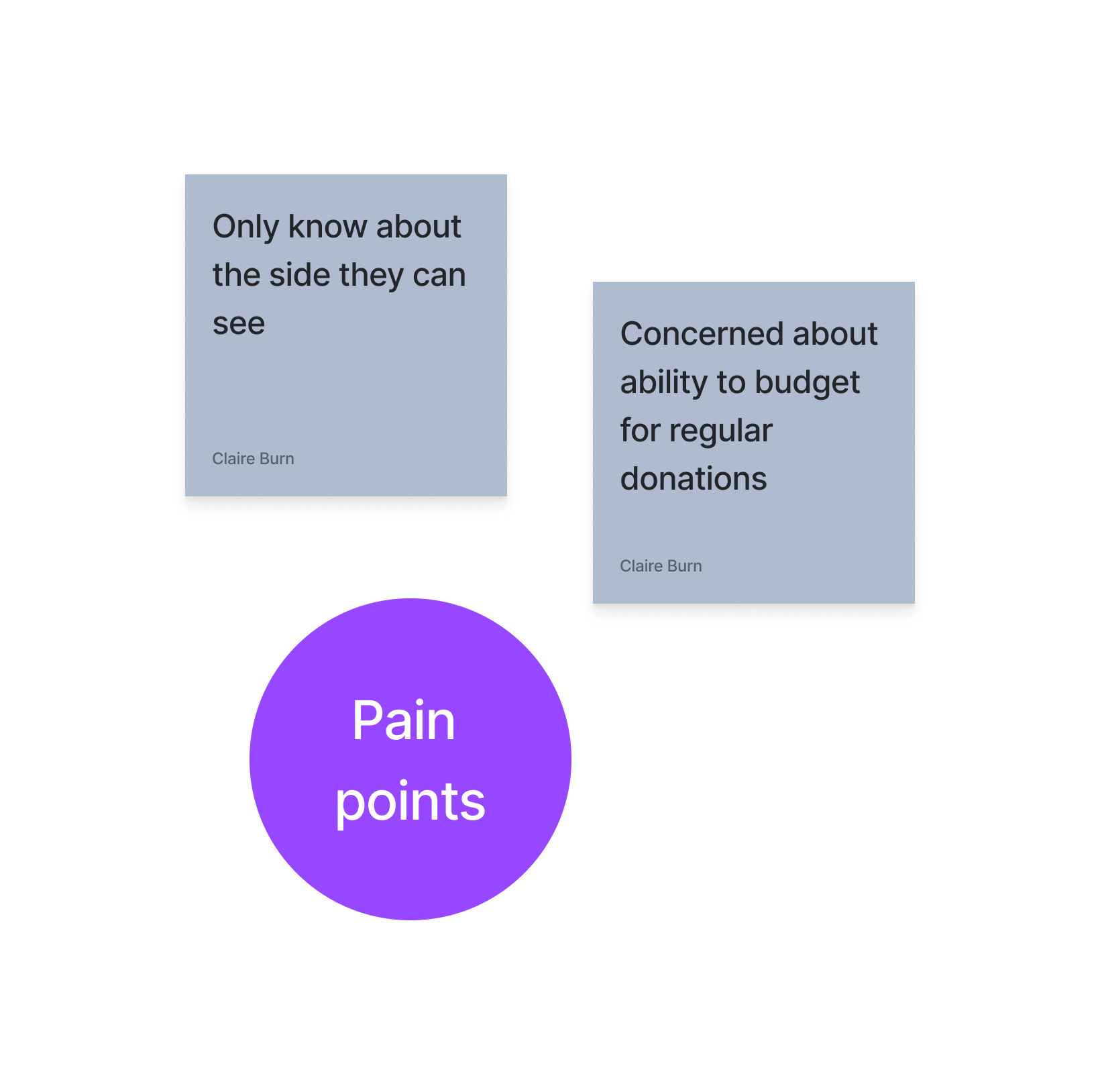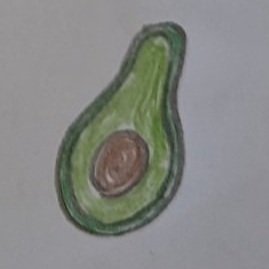Synthesising personas
Now that I’ve gathered some information, I want to start synthesising it so that I can make sense of it, and begin to identify any key themes or patterns. Beginning to analyse now before I’ve completed the discovery stage means that I’ll be able to use my insights to shape future interviews (Baxter et al. 2015) and I’ll hopefully avoid “end-of-discovery analysis paralysis” (Kaley 2023).
Affinity mapping
Affinity mapping, also known as affinity diagramming, “refers to organizing related facts into distinct clusters” (Pernice 2018). One of the main benefits of this method is that it can be done very quicky (Baxter et al. 2015), usually in teams but also as a solo activity too (Pernice 2018).
According to an article by Kara Pernice (2018) for Nielsen Norman Group, there are two steps that I need to follow:
Generate sticky notes with one idea/fact per sticky note
Organise the notes into groups
Step 1: Generating sticky notes
Pernice (2018) recommends writing one idea or fact per sticky note, so this is what I did.
The sticky notes are colour coded, according to where the information came from. Information on the:
Purple sticky notes came from Roundabout’s website analysis reports
Blue sticky notes came from the “data hack” event that a group of Guardian employees did as a volunteering activity
Yellow sticky notes came from an activity completed by a member of the Roundabout team during a marketing training event
Grey sticky notes came from the user research I’ve carried out so far
There’s a lot of information there, making it feel a little chaotic. I’m keen to move onto step 2 and organise the sticky notes into groups.
Steps 2: Organise the sticky notes into groups
In her article, Pernice suggests “creating a few category names to help get the sorting started” (2018). Ideally, I’d like to use the information I’ve gathered to create one or more personas. So, I looked for a persona template I could use and borrowed category names from that as a starting point.
I had a go at using the template and arranging my sticky notes according to the following category names:
Bio
Interests
Influences
Goals
Needs and expectations
Motivations
Pain points and frustrations
Around ten minutes into this, I felt a bit stuck. I had a lot of sticky notes which didn’t seem to fit under the borrowed headings. It made me worry that I hadn’t conducted my research well enough. It was feeling too much. So I decided to take a step back. Creating a few category names before sorting, as recommended by Pernice in her article, wasn’t helping me in that moment.
So I decided to have another go, this time just starting to group sticky notes into clusters, based on the information that seemed related to me. This is more similar to the approach described in the Gamestorming book (Gray et al. 2010). This approach seemed to work better for me and I was able to group my sticky notes.
This gave me enough information to have a go at creating a persona.
Personas
A “persona is a fictional, yet realistic, description of a typical or target user” (Harley 2015). They are not real people, but they are based on information about real users, gathered through user research (Cooper et al. 2014). Personas can “provide us with a precise way of thinking and communicating about how groups of users behave, how they think, what they want to accomplish, and why” (Cooper et al. 2014:62) and they do this in a way which is memorable for teams who are designing and deveoping products or services (Harley 2015).
The information I’ve gathered so far suggests there is more than one potental persona for my project. However, as a starting point, I had a go at creating one.
I feel like I’ve met people like Jackie. She is “a believable and alive character” (Harley 2015) and for that reason, this first iteration of a persona feels useful. I can imagine what hobbies she might have and how she might interact with a charity like Roundabout.
It’s not perfect. At the moment, I am still learning about the users I might be designing my prototype for. I don’t yet understand “the deeper, underlying reasoning behind the preferences and statements-of-fact” (Young 2016). I want to develop a better understanding of her motivations and behaviours. But this persona can evolve. It is enough for now.
Reflections
Having sythesised the data I’ve gathered about potentional users so far and then created a persona, how are my thoughts about how it went.
What went well
When sythesising the information I’d gathered, I’m glad I tried starting with headings as suggested by Pernice in her article (2018). Even though the approach did not work for me this time, perhaps it might work in a different situation. I can now look to her approach and the one suggested by Gray et al. (2010) as two different tools that I can use when needed.
Having created a persona, I can see how it would be a useful tool for me. I am already beginning to imagine how Jackie might interact with a charity like Roundabout and how she might use their digital platforms. However, to be really effective, I need some more information and to develop the persona further.
What could be improved
I’m happy with the persona I created so far and how I used the data I had collected to inform it. However, I do feel there is a lack of behaviour, motivation and frustrations insights. This is something I would like to improve upon and develop as my project progresses.
This type of infromation would also help me to have a go at creating a persona without any demographic data in it, as recommended by Young (2016) in her article. I am a little skeptical of this approach but I am curious to try it and see whether it helps or not.
Future plans
As I move into the Define stage of this project and refine exactly who my target user/s are, I plan to deepen my understanding of those users and really uncover what motivates or frustrates them. I plan to:
Develop the Jackie persona further, using common persona headings such as goals and concerns (Harley 2015)
Consider making another persona during the Define stage of my project
For now, fill the gaps in my knowledge of this persona with my own assumptions
View persona creation as an iterative process, editing and updating persona/s when more information is available
Use the persona/s I create throughout the design process to avoid them becoming “like a piece of artwork” (Salazar 2018)
-
BAXTER, Kathy, Catherine COURAGE and Kelly CAINE. 2015. Understanding Your Users: A Practical Guide to User Research Methods. Second edition. Amsterdam Boston Heidelberg: Elsevier, MK, Morgan Kaufmann.
COOPER, Alan, Robert REIMANN, Dave CRONIN and Alan COOPER. 2014. About Face: The Essentials of Interaction Design. Fourth edition. Indianapolis, IN: John Wiley and Sons.
GRAY, David, Sunni BROWN and James MACANUFO. 2010. Gamestorming: A Playbook for Innovators, Rulebreakers, and Changemakers. 1st ed. Sebastopol, CA: O’Reilly.
HARLEY, Aurora. 2015. ‘Personas Make Users Memorable for Product Team Members’. Nielsen Norman Group [online]. Available at: https://www.nngroup.com/articles/persona/ [accessed 6 Mar 2023].
KALEY, Anna. 2023. ‘Discovery in Agile’. Nielsen Norman Group [online]. Available at: https://www.nngroup.com/articles/discovery-in-agile/ [accessed 26 Feb 2023].
PERNICE, Kara. 2018. ‘Affinity Diagramming: Collaboratively Sort UX Findings & Design Ideas’. Nielsen Norman Group [online]. Available at: https://www.nngroup.com/articles/affinity-diagram/ [accessed 26 Feb 2023].
SALAZAR, Kim. 2018. ‘Why Personas Fail’. Nielsen Norman Group [online]. Available at: https://www.nngroup.com/articles/why-personas-fail/ [accessed 7 Mar 2023].
YOUNG, Indi. 2016. ‘Describing Personas’. Inclusive Software [online]. Available at: https://medium.com/inclusive-software/describing-personas-af992e3fc527 [accessed 6 Mar 2023].
Thank you for reading.












